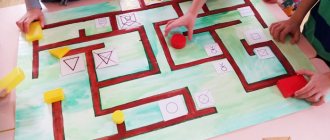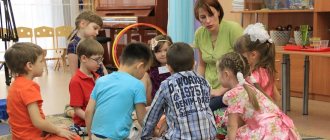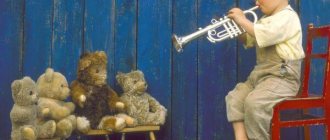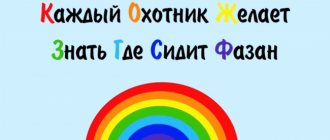Main types of memory
In psychology, memory refers to a number of abilities that record the experience gained, keep it in an active state, for reproduction in the future. The process involves the mechanisms of remembering, storing, reproducing and forgetting.
The development of memory affects the development of the child’s personality.
Information comes to the preschooler through the senses:
- visual - memorizing visible images;
- auditory - everything that the preschooler perceived through the organs of hearing;
- gustatory - memories of the taste of foods eaten;
- olfactory - remembering different aromas;
- tactile - sensations that were received during contact with an object.
Important! Each of the above types must be developed separately, by using the corresponding senses.
Based on duration, children's memory is divided into 2 types:
- Short-term. Information stays in the brain for a short period and disappears after a while. May only last 20-30 seconds.
- Long-term. The experience gained is retained for a long time. It can be mechanical or semantic.
The memory of a preschooler can be either involuntary (information is stored on its own) or voluntary (in order to remember something, you need to make an effort).
Types of memory
What memory predominates in preschool age
Each stage of memory development in preschool age has its own characteristics:
- Children from 0 to one year old develop motor memory quickly. Manifests itself in the form of conditioned reflexes. During this period, the baby observes the actions of his parents and tries to repeat them. Memorization will be effective if learning is accompanied by vivid emotions.
- From one to two years, the Central Unequal System develops. At this age, figurative memorization predominates. The baby recognizes the face of mom and dad and takes his first steps.
- At the age of 2-4 years, the rapid development of mechanical memory in children occurs. The child begins to remember words and think logically.
- In preschoolers aged 4-6 years, involuntary memorization is in the lead. They usually absorb information that seems interesting to them.
Over time, children’s memory mechanisms become stronger and the quality of their thinking improves. Children become more capable of learning.
Specific features of memorization in preschool age
Mechanical memory
Preschoolers have well-developed mechanical memory. They remember without much effort and then reproduce what they saw or heard. The main thing is that the information arouses interest. Sometimes it is called “cramming”; the semantic part of the material fades into the background. Vocabulary quickly improves and increases.
Why is it necessary to develop the memory of preschoolers
The baby doesn’t have to know and remember everything. But, thanks to a good memory, it will be easier for him to learn and live. The development of memory in preschool children improves the functioning of such processes as: attention, thinking, imagination. The older the child gets, the better the memory processes work. All this is due to the fact that the child improves the technique of assimilating new information.
How to learn colors in English with children - useful exercises
Important! You need to train your memory at a very early age, this will give you the opportunity to apply the acquired skills and abilities in the future.
What is memory?
This is a reflection of past experience. It is based on three processes - remembering, storing and reproducing.
Memorization is the process of formation and consolidation of information in the nerve cells of the cerebral cortex in the form of nerve impulses transmitted along the processes of these cells to each other. As a result of this, new neuro-reflex connections are established - ways of receiving and extracting information. In addition, when memorizing, a connection is established between new and existing paths. The connection between individual events, facts, objects or phenomena reflected in our consciousness and fixed in our memory is called association. Without associations, normal human mental activity, including memorization, is impossible.
Incoming information is stored in our memory in the form of a memory trace - an engram. Probably all brain cells take part in its formation and preservation. But science does not yet know exactly in what form this memorable trace is stored. The formed engram is very stable and can be preserved throughout a person’s life, but its extraction, that is, remembering something, can be fraught with great difficulties. However, it has been proven that with learning and memory training, the number of connections between nerve cells becomes more and more, they become stable, which leads to easier retrieval of the engram. Exercises and training on memory development are aimed at solving this problem. The process of storing information in memory consists of two important aspects - the preservation of a memory trace and connections in the brain. Thanks to memorization and preservation, it becomes possible to reproduce information, as well as its recognition (remembering).
Reproduction is the process of the appearance in consciousness of previously perceived information, the execution of memorized movements. During reproduction, images fixed in memory “come to life” quickly without auxiliary, supporting information. So, for example, when a person is explained how to get somewhere, then in addition to the street name and house number, they are given various additional information that there will be a store, a school, or a traffic light on the way. The next time he goes to the same address, no auxiliary information is required to find the desired object, and recall occurs faster. This is called a good memory. But in order to achieve literally automatic reproduction of the necessary information, it is necessary to repeat it several times.
The types of manifestations of memory are extremely diverse. The type classification of memory is based on three main criteria (features):
1.Memorization object
Depending on what exactly a person perceives and reproduces, there are four main types of memory: visual-figurative, which promotes good memorization of faces, sounds, colors, shapes of objects, and so on; verbal-logical (or verbal-semantic), in which information is memorized by ear; motor (motor) - memory of movements and emotional memory, in which experienced feelings, emotions and events are remembered.
2. The degree of volitional regulation of memory
On this basis, memory is divided into voluntary (which is used if you need to remember something and the process itself requires effort from a person) and involuntary (the task of memorizing is not set, it happens by itself)
3. Duration of storing information in memory
According to this criterion, memory is divided into short-term and long-term.
Methods for developing different types of memory in preschoolers
Memory is one of the main mental processes, without which the development of a child’s intelligence is impossible. Many theses, coursework, and abstracts are devoted to this topic. Experts are developing new techniques and techniques that improve a child’s cognitive abilities.
Visual memory processes need to be trained and improved from an early age. The essence of the techniques used is to memorize and subsequently recognize images of animals, birds, plants, and flowers. For older children, they can choose cards with letters and numbers. You can train a preschooler's memory using simple techniques that include various exercises and games.
“What’s wrong here” exercise. There are from 4 to 7 pictures on the table, the child needs to remember what is shown on it. Then the baby turns around, the teacher or parent removes one picture. The baby needs to understand what has changed.
“What’s wrong here” exercise
The development of auditory memory can begin with studying the sound of musical instruments. Information is well absorbed while reading poems and sayings. New words will eventually enter the child’s active vocabulary.
To train your long-term memory, you can play “remember everything.” Let the baby remember and talk about the events of yesterday. The story should be as detailed as possible.
Methods for developing voluntary memory in preschoolers
Voluntary memory is aimed at remembering certain information; the child sets himself the task of first remembering and then remembering.
Important! The development of voluntary memory is one of the prerequisites for a child’s readiness to learn and learn at school.
The development of voluntary memory includes the following stages:
- target selection;
- listen carefully to the task;
- active memorization of necessary information.
For training, you can read ten unrelated words to a preschooler. Then, after reading, the child must reproduce them. Only correct answers are counted. This technique then allows you to observe how the child’s mental abilities develop over a certain period of time.
For this lesson you will need five different colored cards. Within fifteen minutes, the baby must remember where and how the cards are located. After which they are covered with a sheet of paper. The baby must place the colors one after another on his own. The answer is checked against the source.
Methods of memorizing poetry based on picture-graphic diagrams
The memory of preschoolers is characterized by the development of visual-figurative memorization. Young children are characterized by photographic ability, what they see is what they remember. This means that visual material is perceived better than verbal material. To remember a verse, a child needs to repeat it several times. To prevent children from losing interest in the poem, you can use pictures that make sense. After finishing listening, the baby can easily reproduce what he saw. This method speeds up the study of the poem.
Picture-graphic scheme for the nursery rhyme “Our Masha” by N. Burachevskaya
The success of the method of memorizing poetry based on picture-graphic diagrams depends on the formation of a semantic connection between the lines of the verse and the picture. The image helps the baby comprehend and repeat what he heard. Two or four lines are accompanied by a specific design.
Card file of conversations in the second junior group
Important! Learning poetry using pictures is suitable for teaching children with speech impairments and mental retardation (MDD). A special feature of the method is the improvement of long-term memorization and speech development.
Development of figurative memory in children
Figurative memory is closely related to remembering and reproducing past experiences. It is easier for children three to six years old to remember images; they can be either single or multiple.
Methods for developing figurative memory include:
- self-control;
- exercises;
- games;
- inclinations;
- interests.
The success of these techniques depends on the ability to arouse interest in children. For games, you should choose objects of complex shapes, bright colors, and various shades.
Figurative memory training
Group classes will be most effective. You can create a group from family members or involve children from the yard.
There are several training options:
- "Throw and catch." Preschoolers are divided into pairs. Each player is given a ball. After the word stop or number is heard, children throw a ball to a friend, the goal is to catch it.
- “Say the word.” The adult names the letter, the child must come up with a word for it. If the child does not know or is looking for the shortest path, he can use the hint of other participants.
Individual lessons are also useful. When going for a walk, the baby can list the clothes before putting them on. The baby, who does not see things, must name the colors and names.
Important! You can show pictures with different situations. One picture shows a real situation, the second a fictional one. The preschooler must name a fictitious situation. The child is read 10 or 12 words, from which it is necessary to compose a meaningful story.
How to make it easier to learn new information
It is difficult for a child without a good memory to achieve success. Easy memorization techniques will make it easier to learn new information:
- Reading books together with parents. Then there is a prediction of the text, a discussion of the characters. This technique develops curiosity and improves the learning process in a short time.
- Let the child learn the verse a couple of lines at a time, but every day until he has learned the whole thing.
- Vivid presentations make the learning process easier.
- Organizing a sleep and rest schedule helps to absorb information. This means that the more you need to remember, the better quality your sleep should be. The child should spend at least 2-3 hours outdoors.
- Some foods improve memory. The child's diet should include apples, grapes, avocados and dairy products.
The process of assimilation of new information largely depends on how much time parents devote to their child. The earliest memories are included in the process of personality formation; it is during this period that attention and memory predominate in preschoolers. Educational games, reading books, drawing and singing all contribute to the development of memorization.
More on the topic Developing memory:
Children's memory. Instructions for use.
I, like many modern mothers, try to help the baby grow up versatile and grasp on the fly. However, my attempts to engage my two-year-old son with various early development methods did not produce any results. In the end, the features of children's memory were explained to me by the teacher and founder of the children's eco-club “Umnichka” Sofya Timofeeva. I present her five rules: the rules of pleasure, five minutes and five days, the rules of feelings and desire. Rule of pleasure. Memory works better if...
How to teach a first grader to do his homework?
Two weeks have passed, and I already want to take a sedative so as not to break down...
Written lessons are a brain blast. Can write two lines of numbers in a notebook for 30-40 minutes...
He pushes back the start of lessons in every possible way - I don’t want to, I’m tired, I’m tired, I want to eat/drink/etc. and so on.
“I can’t do anything!”...
Does everyone learn so much by heart?
I don’t understand what’s interesting? that memorizing poetry develops memory? don't you agree? 03.10.2012 13:04:08, Bryansk forest.
How to find the right school for your child?
developed: memory, perception, thinking, speech); • about psychological readiness for school; 3. How to independently and with the help of specialists organize a developmental environment for a child...
director's games with figures
I read a lot on the Internet about the benefits of director's games with various figures (for example, boys playing soldiers) and the benefits they bring to the child: this includes the development of memory, fine motor skills, vocabulary of speech and its coherence, and grammatical structure of the language (since such games necessarily accompanied by children's comments). But I just can’t find information about what kind of images kids prefer to use in this game. Of course, it is clear that images from TV and cinema have...
poems by heart in 1st grade
When they ask me, I think whether to shoot or be patient. The teacher says, develop your memory, so we develop it on the nerves of the whole family.
Poems: to teach - not to teach
we don't teach. but in order to be able to go to school later, you need to teach. develop listening memory. otherwise then only the visual will be developed, like most people...
Memory problems
There will be more serious problems ahead. It is necessary to develop auditory memory, visual, mechanical, all types of memory are required.
Diagnosed with mental retardation
Developed memory, logical thinking, speech. As a result, I overdid it a little. :-) And if I were you, I would go to another speech therapist.
Child has poor memory
Study average and below (3.4, sometimes 5). But he has a bad memory: - he can teach for 5-6 hours 2 They examine the child, communicate with him - they say he is a normal and developed child.
09/27/2006 Updated 02/18/2015
Proper and nutritious nutrition improves memory performance
Pay attention to what your child eats, balance proper and nutritious nutrition for a growing body.
You can improve brain nutrition with the following foods: greens, fruits, vegetables, dairy products, nuts, berries, cereals.
Proper nutrition is the key to your child’s good health and improved memory. Food greatly influences the development and improvement of memory. They contain a large amount of useful substances for a growing organism.
Good relationships, care and attention improve a child's memory
If your family has good, friendly relationships, then your child will always remember new information with ease. Try to create a friendly environment in your family, peace, good relationships between parents and children, always have a positive effect on the development of the child’s memory and attention.
When a child sees good relationships in the family, with parents and other family members, then it is easier for him to study, he studies with joy. A child wants to study in a good environment at home and wants to please his parents and other relatives with his successes.
Create a good atmosphere in the family, love your child, spend a lot of time with him, surround him with care and affection, so that the child feels that he is not alone, that he is loved and will always help him.
When there are good relationships in the family, then everything turns out well for the child, his memory becomes better, and his head is not filled with quarrels between his parents.








